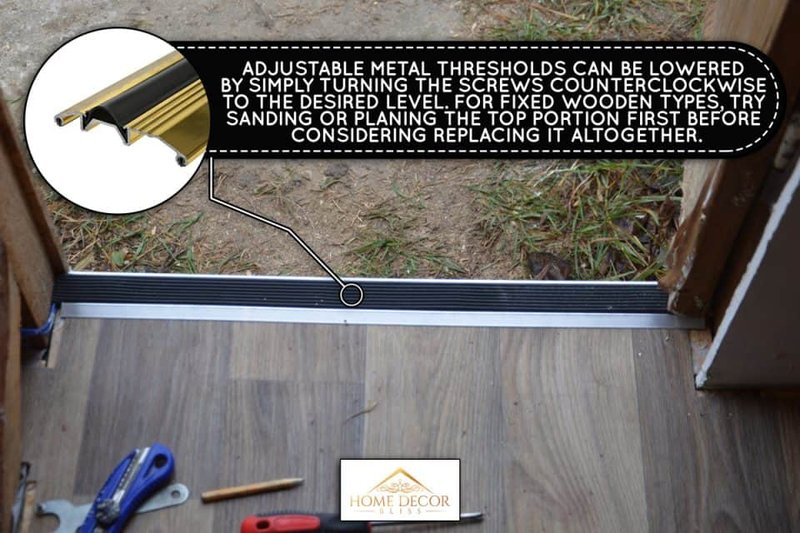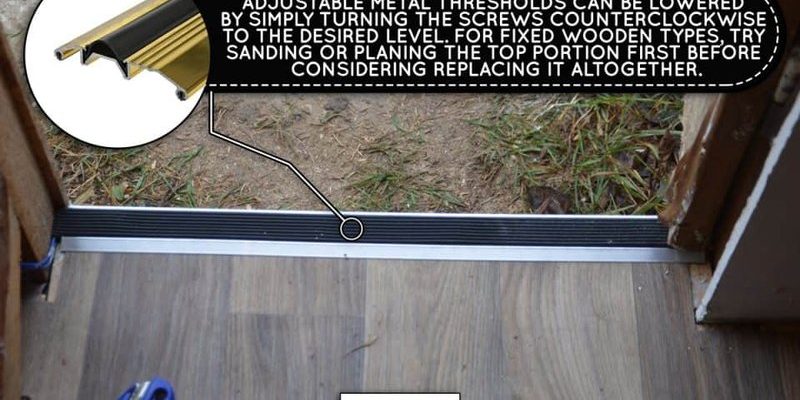
Here’s the thing: thresholds seem simple, but they’re tightly connected to how your doors work. Whether you’ve just installed a shiny new Schlage entryway or you’re wrestling with the original wood doors in an old house, even a tiny bit of extra height in the threshold can make opening the door feel like bench-pressing a refrigerator. Let me walk you through what’s really going on when the threshold is too tall, and how you can fix it—step by step.
What Causes a Threshold to Be Too High?
You might be wondering, “Why would the threshold suddenly be the problem?” Let me explain. Most commonly, a threshold ends up too high for the door clearance because someone did work around it—like installing thicker carpeting, upgrading to new tile, or simply getting a new door. Sometimes, thresholds themselves get replaced with something thicker, or an adjustable threshold gets cranked up too high during weatherproofing. Weatherstripping can also add unintentional height, especially if it’s doubled-up or not seated properly.
A classic example: you move into a house and decide the old, scuffed-up wood threshold needs a refresh. You swap it for a newer model (say, one with better water sealing), but you don’t realize the new one is just a quarter-inch taller. Now, your door barely opens—or gets stuck halfway. Honestly, it’s a common puzzle. Even a few millimeters can make a world of difference.
Other times, the culprit is shifting or settling. Floors settle, frames shift, and suddenly the door starts dragging. It’s not always a DIY blunder, but it sure can feel like one if you’re not expecting it. Old houses especially have a knack for making thresholds rise up like little wooden mountains.
Problems Caused by an Oversized Threshold
A threshold that’s too high isn’t just a literal stumbling block. Let’s look at what actually happens:
- Door drag or sticking: The most obvious sign. Your door scrapes or jams every time you open it.
- Seal failure: If the door can’t close flush, air and water can sneak in—ruining your home’s energy efficiency or letting rain puddle inside.
- Wear and tear: Both the threshold and the door bottom get scuffed, chipped, or bent with repeated scraping. Sometimes the weatherstripping itself gets shredded.
- Squeaking and noise: Doors that grind against too-tall thresholds tend to groan and squeak, which gets annoying fast.
Sometimes, the problem is subtle—a little more resistance or a gap that suddenly appears. But left alone, it snowballs. Hinges loosen, locks misalign, and eventually, even the best doors start acting up. That’s honestly why this isn’t something to ignore.
How to Check If Your Door’s Threshold Is Too High
Before you start grabbing tools, it’s smart to confirm the real issue. Here’s how I usually check:
- Open and close the door slowly. Listen for scraping or feel for resistance at the bottom. Does it get worse if you step down a bit harder on the threshold?
- Inspect the gap. Look at the bottom edge of the door with it closed. There should be a consistent, narrow space—about the thickness of a nickel—between the door and threshold.
- Check for scratch marks. Scuffs or gouges at the bottom of the door or across the threshold are basically a smoking gun.
- Test with paper. Slide a piece of paper under the closed door. If it rips or bunches up, you’re dealing with contact.
If everything looks off at the *bottom*, and the rest of the frame is straight, the threshold’s height is probably your main issue. Don’t worry—it’s a solvable problem.
Simple Fixes for an Adjustable Threshold
Some doors (especially exterior ones, like those using Schlage or Kwikset hardware) have adjustable thresholds—meaning you can tweak the height with a screwdriver. Here’s how to do it:
- Look for screws or plugs along the top of the threshold. These usually sit right under your feet when you open the door.
- Remove any plastic covers or plugs to reveal the screws.
- Use a screwdriver to turn the screws counterclockwise. This will usually lower the threshold in tiny increments.
- Test the door after each adjustment. Lower it just enough so the door clears the threshold, but a slip of paper still feels gently snug (for weather sealing).
- Replace any covers or plugs when finished.
Honestly, this is one of those rare fixes that takes less than five minutes, and you feel like a hero when it works. If the threshold won’t adjust any lower, or if it’s still way too tall, you’ll want to look at more involved solutions.
What to Do When the Threshold Can’t Be Lowered
If your threshold isn’t adjustable—or it’s stuck at its lowest—the next step is some light carpentry. Here’s what that might look like:
- Remove the threshold: Carefully pry it up with a flat pry bar or screwdriver. Be gentle so you don’t crack the frame or floor.
- Check if it can be trimmed: If the threshold is wood or a soft composite, you might be able to sand or plane it down from the top or bottom. For metal or rigid types, replacement is usually easier.
- Install a thinner threshold: Measure your current threshold. Look for a thinner or lower-profile replacement at your local hardware store. Don’t forget to check for compatible weatherstripping.
- Reinstall carefully: Make sure the new piece sits flat, is well-sealed, and allows the door to clear with a nickel’s width of space.
If you’re not handy, there’s no shame in calling in a local carpenter, especially if your door frame is old, fragile, or water-damaged. They’ll have the tools (and patience) to get the fit just right without risking splintered wood.
Comparing Universal and Brand-Specific Thresholds
You might be tempted to grab a universal threshold to solve your clearance issue. There are pros and cons here.
- Universal thresholds often fit a wide range of door frames. They’re budget-friendly and easy to find at any hardware store. But sometimes, the fit is a bit sloppy, and you might lose a bit of that tight weather seal.
- Brand-specific thresholds (like those from Schlage) are designed for that exact door or system. The fit is precise, and the look usually matches. On the flip side, they often cost a bit more, and you’ll need to be sure you’re buying the right model for your exact door series.
Here’s my honest take: If you have a high-traffic exterior door and want the best performance, spend the extra on the brand-specific part. For low-traffic or interior doors, a universal usually does just fine.
When to Trim the Door Instead of the Threshold
Sometimes, the threshold is actually the right height, but it’s the door that’s too long—especially if you’ve added thick flooring, new rugs, or an extra layer of underlayment. Let me explain how to handle that.
- Take the door off the hinges. This is usually simple—just pop the hinge pins with a screwdriver and mallet.
- Lay the door flat on a pair of sawhorses, or even just on two chairs.
- Mark a straight line across the bottom using a level or straightedge. Always check twice. A wonky cut will haunt you.
- Trim a little at a time. Use a circular saw or hand plane, taking off just 1/8″ per pass. It’s easy to take off more, but impossible to put it back on.
- Rehang and test the fit. Make sure the door clears the threshold but still gets a good seal when closed.
Honestly, this option is great if the door itself is the real troublemaker. But if you’re dealing with a historic or solid wood door, consider having a pro do the cutting to avoid disaster.
Extra Tips for Weather Sealing and Long-Term Fixes
Once the clearance is just right, don’t forget the finishing touches. Over time, doors and thresholds can drift out of alignment again, so it’s smart to double-check the weatherproofing as well.
- Replace old weatherstripping: Basically, if it’s brittle or cracking, swap it for a new foam or rubber style that fits the new gap snugly.
- Clear out dirt or debris: A surprisingly common “height” issue is just a buildup of grit under the threshold strip, especially in doorways exposed to the outdoors.
- Secure loose fasteners: Screws or nails that have worked loose can let the threshold wobble or tilt, causing uneven clearance.
- Check alignment twice a year: A quick visual check in spring and fall helps you catch small shifts before they become big headaches.
The best fix for a too-high threshold is the one that lasts—so take your time, measure twice, and double-check the seal before calling it done.
Wrapping Up: Living with a Properly-Fitted Threshold
Fixing a threshold that’s too high for your door clearance is one of those small home maintenance jobs that pays off every single day. No more dragging, scraping, or sweaty wrestling matches with a stubborn door. Whether you tweak an adjustable threshold, swap in a lower-profile model, or trim the door itself, you’ll end up with a smoother swing and a better seal. Plus, you’ll probably save money on energy bills and avoid bigger repairs down the line.
If your door suddenly starts sticking, don’t ignore it or start blaming your luck. Most of the time, it’s just a little threshold drama—easy to diagnose, and (with a screwdriver or a little elbow grease) easy to fix. So take it step by step, keep your tools handy, and know that even the toughest door can be tamed with a bit of smart troubleshooting.
